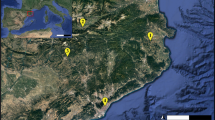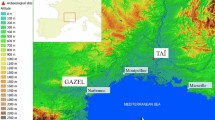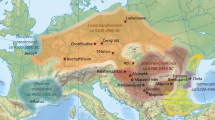Abstract
In temperate Europe, sheep predominantly mate in autumn and lamb in the spring. In contrast, present-day Mediterranean husbandries practice autumn lambing, with benefits in terms of natural resource use and seasonal availability of animal products. Autumnal lambing is enabled by the conjunction of a capability of some Mediterranean breeds for “out-of-season” breeding, intentional scheduling by the herder, and autumnal rains providing forage resources for lactation. Autumn and winter sheep births have been demonstrated at Neolithic sites in the western Mediterranean. More works are needed to define the conditions leading to their emergence. This line of research uses oxygen isotope analysis in sheep teeth and involves modern references to define birth season. The existing references were biased in favor of winter and spring births. In this study, we enlarge them with 30 additional teeth from Lacaune and Merino sheep, including mainly summer and autumn births. Experiments were also conducted on Lacaune ewes, to address theoretical grounds on the implementation of autumn births: it implies to preserve females from conceptions by separating the sexes in autumn and re-introducing the rams among females in the spring. This second step also produces a “male effect.” We show that in the Lacaune breed, the proportion of spontaneously cyclic ewes in the spring is low in the absence of males and remains minor when the ewes are left in permanent contact with rams. On the other hand, we were able to implement a highly efficient male effect using non-sexually stimulated males, demonstrating that this practice could have been implemented by Neolithic herders.





Similar content being viewed by others
Data Availability
Data generated in this study are included in this article and its supplementary information files.
References
Avdi, M., & Chemineau, P. (1998). Reproductive and productive performance in Chios ewes mated in spring or in autumn. Reproduction Nutrition Développement, 38, 551–558.
Avdi, M., Banos, G., Kouttos, A., Pampoukidou, A., Bodin, L., Chemineau, P. (2002). Genetic variability of spontaneous out-of-season ovulatory activity in Chios sheep. 7th World Congress on Genetics Applied to Livestock Production Montpellier 19–23 August, (pp. 756–768).
Balasse, M., & Tresset, A. (2007). Environmental constraints on reproductive activity of domestic sheep and cattle: What latitude for the herder? Anthropozoologica, 42(2), 71–88.
Balasse, M., Smith, A. B., Ambrose, S. H., & Leigh, S. R. (2003). Determining sheep birth seasonality by analysis of tooth enamel oxygen isotope ratios: The Late Stone Age site of Kasteelberg (South Africa). Journal of Archaeological Science, 30, 205–215.
Balasse, M., Tresset, A., Dobney, K., & Ambrose, S. H. (2005). The use of isotope ratios to test for seaweed eating in sheep. Journal of Zoology, 266, 283–291.
Blaise, E., & Balasse, M. (2011). Seasonality and season of birth of modern and late Neolithic sheep from southeastern France using tooth enamel δ18O analysis. Journal of Archaeological Science, 38, 3085–3093. https://doi.org/10.1016/j.jas.2011.07.007
Balasse, M., Obein, G., Ughetto-Monfrin, J., & Mainland, I. (2012). Investigating seasonality and season of birth in past herds: A reference set of sheep enamel stable oxygen isotope ratios. Archaeometry, 54(2), 349–368. https://doi.org/10.1111/j.1475-4754.2011.00624.x
Balasse, M., Tresset, A., Bălăşescu, A., Blaise, E., Tornero, C., Gandois, H., Fiorillo, D., Nyerges, É. Á., Frémondeau, D., Banffy, E., & Ivanova, M. (2017). Sheep birth distribution in past herds: A review for prehistoric Europe (6th to 3rd millennia BC). Animal. https://doi.org/10.1017/S1751731117001045
Balasse, M., Renault-Fabregon, L., Gandois, H., Fiorillo, D., Gorczyk, J., Bacvarov, K., & Ivanova, M. (2020). Neolithic sheep birth distribution: Results from Nova Nadezhda (sixth millennium BC, Bulgaria) and a reassessment of European data with a new modern reference set including upper and lower molars. Journal of Archaeological Science, 118, 105–139. https://doi.org/10.1016/j.jas.2020.105139
Barillet, F., Lagriffoul, G., Marnet, P. G., Larroque, H., Rupp, R., Portes, D., Bocquier, F., & Astruc, J. M. (2016). Objectifs de sélection et stratégie raisonnée de mise en œuvre à l’échelle des populations de brebis laitières françaises. INRA Productions Animales, 29(1), 19–40.
Brooke C. H., Ryder M. L. (1979). Races ovines méditerranéennes en régression. United Nations FAO.
Bryant, J. D., Froelich, P. N., Showers, W. J., & Genna, B. J. (1996a). A tale of two quarries: Biologic and taphonomic signatures in the oxygen isotope composition of tooth enamel phosphate from modern and Miocene equids. Palaios, 11, 397–408.
Bryant, J. D., Froelich, P. N., Showers, W. J., & Genna, B. J. (1996b). Biologic and climatic signals in the oxygen isotopic composition of Eocene-Oligocene equid enamel phosphate. Palaeogeography, Palaeoclimatology, Palaeoecology, 126, 75–90.
Canépa, S., Lainé, A. L., Bluteau, A., Fagu, C., Flon, C., & Monniaux, D. (2008). Validation d’une méthode immunoenzymatique pour le dosage de la progestérone dans le plasma des ovins et des bovins. Cahiers Des Techniques De L’INRA, 64, 19–30.
Chasles, M., Chesneau, D., Moussu, C., Delgadillo, J. A., Chemineau, P., & Keller, M. (2016). Sexually active bucks are efficient to stimulate female ovulatory activity during the anestrus season also under temperate latitudes. Animal Reproduction Science, 168, 86–89.
Chazin, H. (2021). Multi-season reproduction and pastoralist production strategies: New approaches to birth seasonality from the South Caucasus region. Journal of Field Archaeology, 46, 448–460.
Chemineau, P., Guillaume, D., Migaud, M., Thiéry, J. C., Pellicer-Rubio, M. T., Malpaux, B. (2008). Seasonality of reproduction in mammals: intimate regulatory mechanisms and practical implications. Reproduction in Domestic Animals, 43 (suppl 2), 40–47.
Chen, G., Schnyder, H., & Auerswald, K. (2017). Model explanation of the seasonal variation of δ18O in cow (Bos taurus) hair under temperate conditions. Scientific Reports, 7, 320. https://doi.org/10.1038/s41598-017-00361-y
Ciuti, S., Pipia, A., Grignolio, S., Ghiandai, F., & Apollonio, M. (2009). Space use, habitat selection and activity patterns of female Sardinian mouflon (Ovis orientalis musimon) during the lambing season. European Journal of Wildlife Research, 55, 589–595.
D’Angela, D., & Longinelli, A. (1990). Oxygen isotopes in living mammal’s bone phosphate: Further results. Chemical Geology: Isotope Geoscience Section, 86, 75–82.
Delgadillo, J. A., Flores, J. A., Véliz, F. G., Hernández, H. F., Duarte, G., Vielma, J., Poindron, P., Chemineau, P., & Malpaux, B. (2002). Induction of sexual activity in lactating anovulatory female goats using male goats treated only with artificially long days. Journal of Animal Sciences, 80(11), 2780–2786.
Fabre, M., Bréhard, S., Hanot, P., Fiorillo, D., Vaquer, J., Balasse, M. (2021). Nouvel éclairage sur les systèmes d’élevage ovins du Chasséen. Reproduction, alimentation et productions animales à Auriac, Carcassonne (Aude, France). In E. Nicoud, M. Balasse, Desclaux E. & Théry-Parisot I. (Eds), Biodiversities, environments and societies since Prehistory: new markers and integrated approaches. 41es rencontres internationales d’archéologie et d’histoire – Nice Côte d’Azur (pp. 101–112). Editions APDCA.
Girard, L. (1983). Moyens employés avec succès, par M. Morel de Vindé, Membre de la Société d’Agriculture de Seine et Oise, pour obtenir, dans le temps le plus court possible, la fécondation du plus grand nombre des brebis portières d’un troupeau. Ephémérides de la Société d’Agriculture du Département de l’Indre pour l’An 1813, Séance du 5 Septembre, VIII Cahier, Châteauroux, Département de l’Indre. VII, 66–68.
Hadjisterkotis, E. S., & Bider, J. R. (1993). Reproduction of Cyprus mouflon Ovis gmelini ophion in captivity and in the wild. International Zoo Yearbook, 32, 125–131.
Hadjikoumis, A., Vigne, J.-D., Simmons, A., Guilaine, J., Fiorillo, D., & Balasse, M. (2018). Autumn/winter births in traditional and Pre-Pottery Neolithic caprine husbandry in Cyprus: evidence from ethnography and stable isotopes. Journal of Anthropological Archaeology, 53, 102–111. https://doi.org/10.1016/j.jaa.2018.12.001
Hafez, E. S. E. (1952). Studies on the breeding season and reproduction of the ewe. Part I. The breeding season in different environments. Part II. The breeding season in one locality. Journal of Agricultural Science, 42, 189–231.
Hanocq, E., Bodin, L., Thimonier, J., Teyssier, J., Malpaux, B., & Chemineau, P. (1999). Genetic parameters of spontaneous spring ovulatory activity in Mérinos d’Arles sheep. Genetics Selection Evolution, 31(1), 77–90.
Hermes, T. R., Schmid, C., Tabaldiev, K., & Motuzaite Matuzeviciute, G. (2022). Carbon and oxygen stable isotopic evidence for diverse sheep and goat husbandry strategies amid a Final Bronze Age farming milieu in the Kyrgyz Tian Shan. International Journal of Osteoarchaeology, 32, 792–803.
Jones, H., Leigh, F. J., Mackay, I., Bower, M. A., Smith, L. M. J., Charles, M. P., Jones, G., Jones, M. K., Brown, T. A., & Powell, W. (2008). Population-based resequencing reveals that the flowering time adaptation of cultivated barley originated east of the fertile crescent. Molecular Biology and Evolution, 25, 2211–2219. https://doi.org/10.1093/molbev/msn167
Karsch, F. J., Bittman, E. L., Foster, D. L., Goodman, R. L., Legan, S. J., & Robinson, J. E. (1984). Neuroendocrinal basis of seasonal reproduction. Recent Progress in Hormone Research, 40, 185–232.
Land, L. S., Lundelius, E. L., & Valastro, S. (1980). Isotopic ecology of deer bones. Palaeogeography, Palaeoclimatology, Palaeoecology, 32, 143–151.
Liu, X., Lister, D. L., Zhao, Z., Petrie, C. A., Zeng, X., Jones, P. J., Staff, R. A., Pokharia, A. K., Bates, J., Singh, R. N., Weber, S. A., Matuzeviciute, G. M., Dong, G., Li, H., LuÈ, H., Jiang, H., Wang, J., Ma, J., Tian, D., … Jones, M. K. (2017). Journey to the east: DIVERSE routes and variable flowering times for wheat and barley en route to prehistoric China. PLoS ONE, 12(11), e0187405. https://doi.org/10.1371/journal.pone.0187405
Malpaux, B., Viguié, C., Skinner, D. C., Thiéry, J. C., & Chemineau, P. (1997). Control of the circannual rhythm of reproduction by melatonin in the ewe. Brain Research Bulletin, 44, 431–438.
Martin, G. B., Oldham, C. M., Cognié, Y., & Pearce, D. T. (1986). The physiological-responses of anovulatory ewes to the introduction of rams - a review. Livestock Production Science, 15(3), 219–247.
Mauléon, P., & Dauzier, L. (1965). Variations de durée de l’anoestrus de lactation chez les brebis de race Ile-de-France. Annales de Biologie Animale Biochimie Biophysique, 5(I), 131–143.
Milhaud, G., & Nezit, J. (1991). Développement des molaires chez le mouton. Etude morphologique, radiographique et microdurométrique. Recueil de Médecine vétérinaire, 167(2), 121–127.
Perret, G. (1986). Races ovines. In ITOVIC Institut Technique de l’Elevage Ovin et Caprin (Ed. Paris) 441pp.
Peters, J., von den Driesch, A., & Helmer, D. (2005). The upper Euphrates-Tigris basin: cradle of agropastoralism? In J.-D. Vigne, J. Peters & D. Helmer (Eds) First steps of animal domestication. New archaeozoological approaches. Proceedings of the 9th ICAZ Conference, Durham 2002 (pp. 96–124). Oxbow books.
Pfeffer, P. (1967). Le Mouflon de Corse (Ovis ammon musimon Schreber 1782); position systématique, écologie et éthologie comparées. Mammalia, 31(Suppl), 1–262.
Rendu C. 2003. La montagne d’Enveig. Une estive pyrénéenne dans la longue durée. Editions Trabucaire.
Rozanski, K., Araguas-Araguas, L., Gonfiantini, R. (1993). Isotopic patterns in modern global precipitation. In P. K. Stwart, K. C. Lohmann, J. McKenzie & S. Savin (Eds.), Climate Change in Continental Isotope Records (pp.1–36). American Geophysical Union
Sierra, A., Balasse, M., Rivals, F., Fiorillo, D., Utrilla, P., & Saña, M. (2021). Sheep husbandry in the early Neolithic of the Pyrenees: New data on feeding and reproduction in the cave of Chaves. Journal of Archaeological Science: Reports, 37, 102935. https://doi.org/10.1016/j.jasrep.2021.102935
Talibov, T. H., Weinberg, P. I., Mammadov, I. B., Mammadov, E. N., Talibov, S. T. (2009). Conservation strategy of the Asiatic mouflon (Ovis [orientalis] gmelini Blyth) and the Bezoar goat (Capra aegagrus Erxleben) in Azerbaijan. In Zazanashvili, N., Mallon, D. (Eds) Status and protection of globally threatened species in the Caucasus (p.46–52). CEPF Biodiversity Investments in the Caucasus Hotspot 2004–2009, Tiblisi.
Thiéry, J. C., Chemineau, P., Hernandez, X., Migaud, M., & Malpaux, B. (2002). Neuroendocrinal interactions and seasonality. Domestic Animal Endocrinology, 23, 87–100.
Thimonier, J. (2000). Progesterone level analysis for the determination of the physiological status of female farm animals. Productions Animales, 13(3), 177–183.
Todaro, M., Dattena, M., Acciaioli, A., Bonanno, A., Bruni, G., Caroprese, M., Mele, M., Sevi, A., & Trabalza Marinucci, M. (2015). Aseasonal sheep and goat milk production in the Mediterranean area: Physiological and technical insights. Small Ruminant Research, 126, 59–66.
Tornero, C., Bălăşescu, A., Ughetto-Monfrin, J., Voinea, V., & Balasse, M. (2013). Seasonality and season of birth in early Eneolithic sheep from Cheia (Romania): methodological advances and implications for animal economy. Journal of Archaeological Science, 40, 4039–4055. https://doi.org/10.1016/j.jas.2013.05.013
Tornero, C., Balasse, M., Bălăşescu, A., Chataigner, C., Gasparyan, B., & Montoya, C. (2016a). The altitudinal mobility of wild sheep at the Epigravettian site of Kalavan 1 (Lesser Caucasus, Armenia): Evidence from a sequential isotopic analysis in tooth enamel. Journal of Human Evolution, 97, 27–36.
Tornero, C., Balasse, M., Molist, M., & Sana, M. (2016b). Seasonal reproductive patterns of early domestic sheep at Tell Halula (PPNB, Middle Euphrates Valley): Evidence from sequential oxygen isotope analyses of tooth enamel. Journal of Archaeological Science: Reports, 6, 810–818.
Tornero, C., Balasse, M., Bréhard, S., Carrère, I., Fiorillo, D., Guilaine, J., Vigne, J.-D., & Manen, C. (2020). Early evidence of sheep lambing de-seasoning in the Western Mediterranean in the sixth millennium BCE. Scientific Reports, 10, 12798. https://doi.org/10.1038/s41598-020-69576-w
Tresset, A., & Vigne, J.-D. (2011). Last hunter-gatherers and first farmers of Europe. Comptes Rendus Biologies, 334, 182–189.
Véliz, F. G., Moreno, S., Duarte, G., Vielma, J., Chemineau, P., Poindron, P., Malpaux, B., & Delgadillo, J. A. (2002). Male effect in seasonally anovulatory lactating goats depends on the presence of sexually active bucks, but not estrous females. Animal Reproduction Sciences, 72(3–4), 197–207.
Ventresca Miller, A. R., Harudae, A., Varfolomeev, V., Goryachev, A., & Makarewicz, C. A. (2020). Close management of sheep in ancient Central Asia: evidence for foddering, transhumance, and extended lambing seasons during the Bronze and Iron Ages. STAR: Science & Technology of Archaeological Research., 6, 41–60.
Weinreb, M. M., & Sharav, Y. (1964). Tooth development in sheep. American Journal of Veterinary Research, 25(107), 891–908.
Worley, F., Baker, P., Popkin, P., Hammon, A., & Payne, S. (2016). The Sheep Project (2): the effects of plane of nutrition, castration and the timing of first breeding in ewes on dental eruption and wear in unimproved Shetland sheep. J Archaeol Sci: Rep, 6, 862–874.
Zazzo, A., Balasse, M., Passey, B. H., Moloney, A. P., Monahan, F. J., & Schmidt, O. (2010). The isotope record of short−and long−term dietary changes in sheep tooth enamel: Implications for quantitative reconstruction of paleodiets. Geochimica et Cosmochimica Acta, 74, 3571–3586.
Zeder, M. A. (2008). Domestication and early agriculture in the Mediterranean Basin: Origins, diffusion, and impact. Proceedings of the National Academy of Sciences, 105, 11597–11604.
Zeder, M. A. (2015). Core questions in domestication research. Proceedings of the National Academy of Sciences, 112(11), 3191–3198.
Acknowledgements
We would like to thank David Portes and Charlotte Allain (INRAE La Fage experimental unit) for taking blood samples on the Lacaune sheep, the INRAE hormone assay laboratory at Tours-Nouzilly. The Lacaune sheep mandibles were provided by the Confédération Générale de Roquefort- Service élevage; we thank the butchers at the Theix INRAE center for the Lacaune sheep mandibles’ treatment. The Domaine du Merle experimental farm is part of Montpellier SupAgro. We thank Pierre-Marie Bousquet and his team for providing us the Merino sheep teeth, in particular Gaëlle Besche for her technical support. We thank two anonymous reviewers for their meaningful comments.
Funding
This project has received financial support from the INRAE and the CNRS through the MITI interdisciplinary programs (“AgroPaléoRepro” project, 2019–2020).
Author information
Authors and Affiliations
Contributions
Marie Balasse, Philippe Chemineau, and Matthieu Keller conceptualized the study. Material preparation and data acquisition and analysis were performed by Marie Balasse, Philippe Chemineau, Matthieu Keller, Sara Parisot, and Denis Fiorillo. The first draft of the manuscript was written by Marie Balasse, Philippe Chemineau, and Matthieu Keller, and all authors commented on previous versions of the manuscript. All authors read and approved the final manuscript.
Corresponding author
Ethics declarations
Ethics Approval
The experiment on the Lacaune sheep received approval by the ethics committee on animal experimentation, science and health (SSA), no. 115. The decision to authorize the project is referenced as APAFIS#22807–2019110814002486.
Competing Interests
The authors declare no competing interests.
Additional information
Publisher's Note
Springer Nature remains neutral with regard to jurisdictional claims in published maps and institutional affiliations.
Supplementary Information
Below is the link to the electronic supplementary material.
Rights and permissions
Springer Nature or its licensor (e.g. a society or other partner) holds exclusive rights to this article under a publishing agreement with the author(s) or other rightsholder(s); author self-archiving of the accepted manuscript version of this article is solely governed by the terms of such publishing agreement and applicable law.
About this article
Cite this article
Balasse, M., Chemineau, P., Parisot, S. et al. Experimental Data from Lacaune and Merino Sheep Provide New Methodological and Theoretical Grounds to Investigate Autumn Lambing in Past Husbandries. J Archaeol Method Theory 31, 75–92 (2024). https://doi.org/10.1007/s10816-022-09600-7
Accepted:
Published:
Issue Date:
DOI: https://doi.org/10.1007/s10816-022-09600-7




